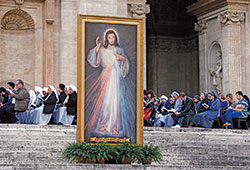St. John Paul II Parish to highlight patron’s devotion to Divine Mercy

An image of Jesus of Divine Mercy is seen as Pope Francis leads a prayer service on the eve of the feast of Divine Mercy in St. Peter’s Square at the Vatican on April 2, 2016. (CNS photo/Paul Haring)
This October is a noteworthy month for St. John Paul II. The 40th anniversary of his election as pope falls on Oct. 16, and his feast day is just six days later, on Oct. 22.
It stands to reason, then, that St. John Paul II Parish in Sellersburg will host an event in October to celebrate its patron. They have invited speakers to lead a presentation and holy hour—not on the saint’s life, not on his papacy, but on … Divine Mercy?
If the theme seems a bit astray from the topic of St. John Paul II, think again.
“He was a big proponent of the Divine Mercy devotion—he’s the one who instituted it,” explains Father Thomas Clegg, pastor of St. John Paul II Parish. “It will be a great way to celebrate our patronal feast day.”
The Divine Mercy devotion springs from apparitions and internal messages (known as locutions) of Christ to Our Lady of Mercy Sister Faustina Kowalska in Poland in the 1930s. She documented the messages in a diary, messages that focused on mercy and his desire for Sister—now Saint—Faustina to spread this message and devotion to the Divine Mercy throughout the world.
(Related story: Divine Mercy presentations scheduled in October at area parishes, schools)
After her death, the diary was translated and sent to the Vatican. But due to errors in the translation, the Divine Mercy devotion was banned by the Vatican in 1959.
Enter Archbishop Karol Wojtyla of Krakow, Poland. In 1965, he ordered investigations into the heroic virtues of Sister Faustina. He also requested a critical analysis of her diary in its correctly translated form.
Thanks to his efforts, the Vatican lifted the ban on the Divine Mercy devotion in April of 1978. Six months later, then-Cardinal Wojtyla became Pope John Paul II.
Parishioner Phyllis Burkholder, who helped organize the event, says it is “really going to celebrate the life and legacy of the patron saint of our [parish].
“It was the message of mercy and the Divine Mercy devotion that defined his pontificate,” she explains. Referring to paragraph 1732 of the diary, she notes that Christ “told St. Faustina that from Poland would come the spark that prepares the world for his final coming—which of course we have no idea when it will happen. The three Polish saints of the 20th century—St. John Paul II, St. Maximilian Kolbe, St. Faustina—have kept that ‘spark’ alive, leading up to the election of Pope John Paul II.”
The free, public event on Oct. 21 will be presented by Dave and Joan Maroney, founders and directors of Mother of Mercy Messengers (MOMM).
Founded in 1999, MOMM is an apostolate of the Marian Fathers of the Immaculate Conception’s National Shrine of Divine Mercy in Stockbridge, Mass. Its mission is to share and assist others in sharing the Divine Mercy message and devotion.
“The Divine Mercy message is so relevant today because so many people are realizing they’ve made serious mistakes in the past or are living in difficult situations,” says Joan. “People are falling into despair and losing hope. They need to know that the Lord … wants to reconcile us all back to him, to help us find peace in our families, our hearts, our country and our world.”
The event at St. John Paul II (one of six MOMM events scheduled in central and southern Indiana in October—see related article on this page) will begin with a multi-media presentation from 6-7 p.m. called “The Spark from Poland Ignites Young Hearts and Families.” From 7-8 p.m. the Maroneys will lead participants in a holy hour of hymns, prayers and mediations before the Blessed Sacrament. Priests will also be available for the sacrament of reconciliation.
“We try to do a day of reflection—or an evening, in this case—every fall,” says Father Clegg. “There’ve always been speakers. With the holy hour, this one will be more spiritual and devotional, which I think will be good for the parish.”
The next day—St. John Paul II’s feast day—the Maroneys will offer two age-appropriate presentations similar to the previous night’s topic but geared for students of the parish’s school.
“Christ told St. Faustina, ‘By means of this image I shall grant many graces to souls,’ ” says Joan, quoting from paragraph 742 of the saint’s diary. “So we give all the students blessed images of the Divine Mercy.”
Burkholder hopes that by focusing on Divine Mercy in honor of the feast of St. John Paul II, parishioners “will have a greater understanding of God’s mercy,” and “see the connection between their parish patron and the Divine Mercy message. St. John Paul II was such a gift. He wrote so much and contributed so much.”
Father Clegg states his goals for the event through the lens of the parish’s mission statement.
“As with all parish spiritual opportunities, we hope [this event] inspires growth,” he says. “We want people learning more about Jesus, following him more closely.
“Our number one mission is to form people who have a personal relationship with Jesus and feel comfortable sharing their faith with others. With this event, as with all we do, we hope to draw people into that relationship.”
(The Divine Mercy presentation, which is free and open to the public, will take place in the church at the parish’s St. Paul Campus, 218 Schellers Ave., in Sellersburg, on Oct. 21. The presentation is from 6-7 p.m., followed by a holy hour and confessions from 7-8 p.m. For more information, contact Phyllis Burkholder at 812-246-2252 or Esther Endris at 812-883-3563.) †
